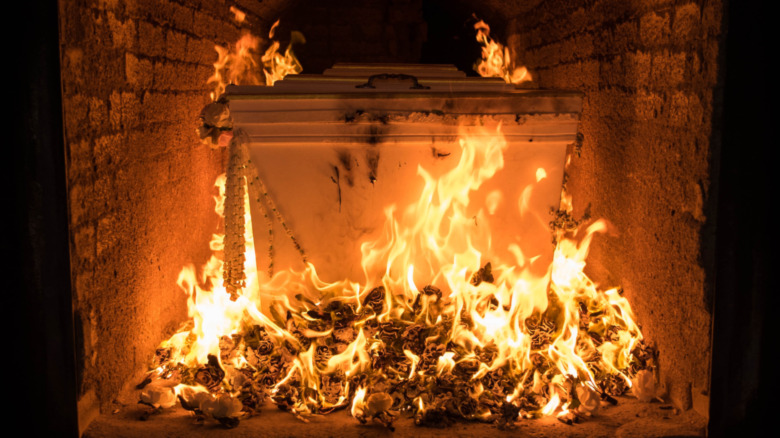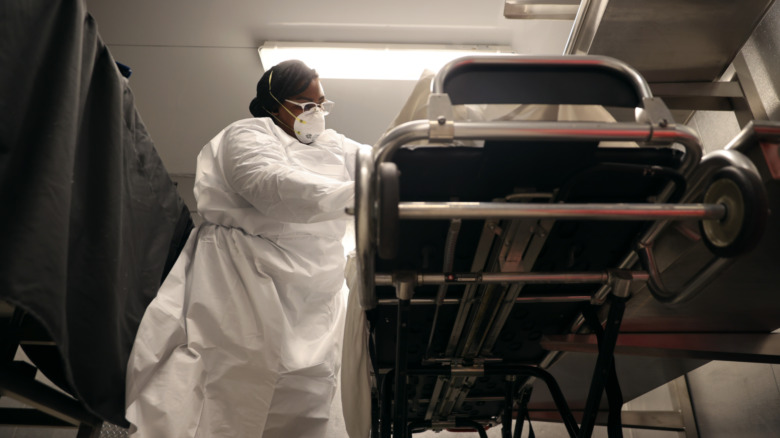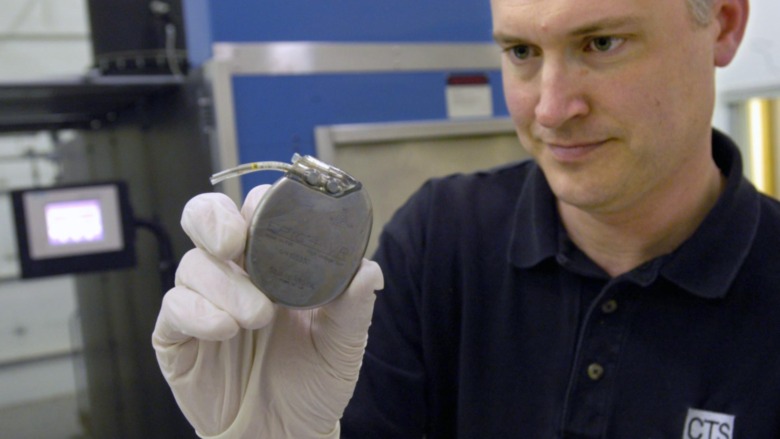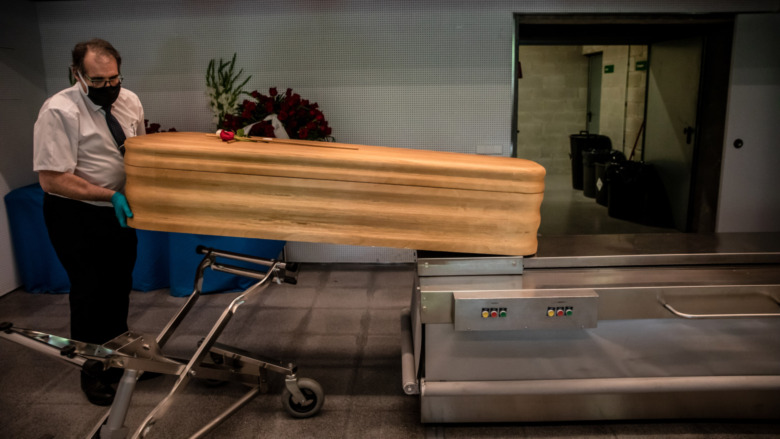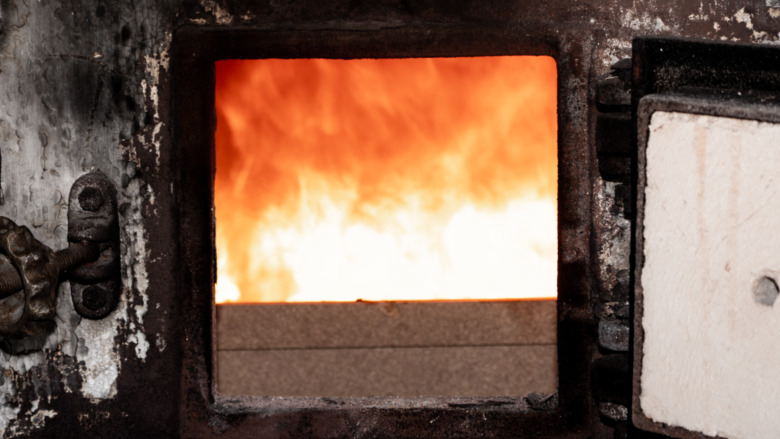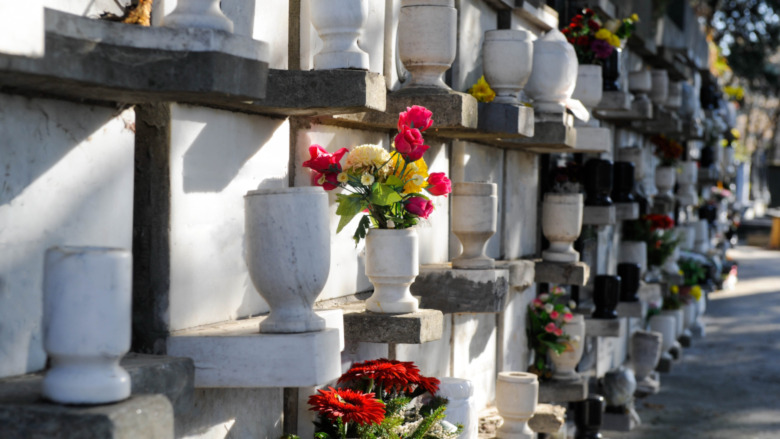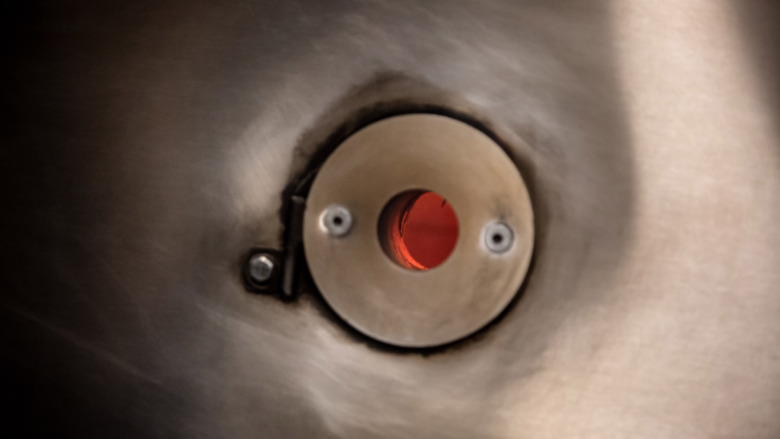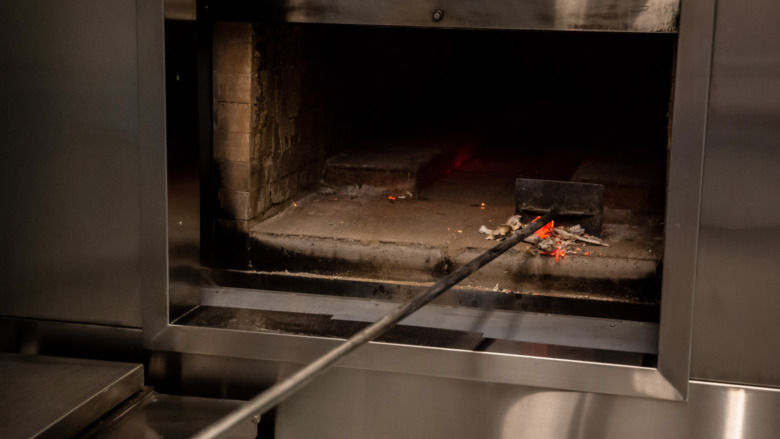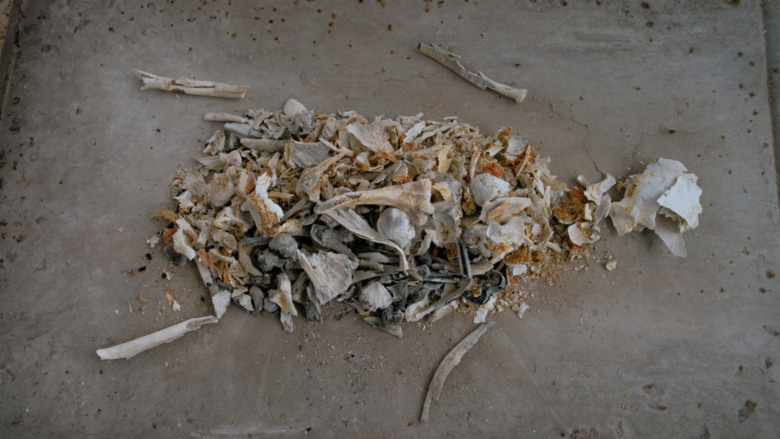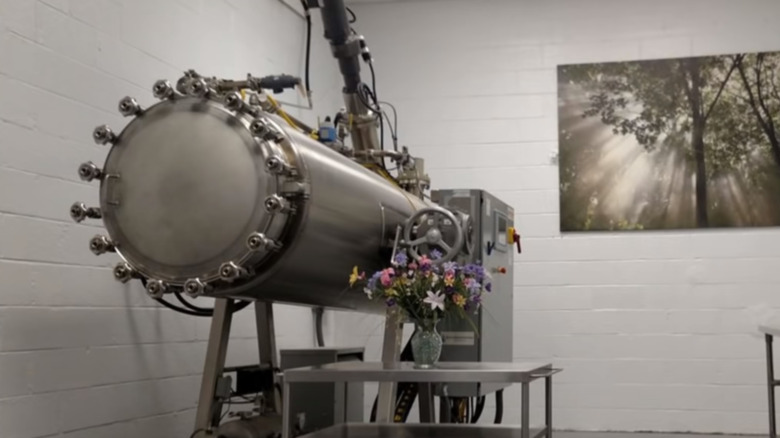Here's What Happens To A Body When It's Cremated
"Dust thou art, to dust returnest."
Nothing evokes Henry Wadsworth Longfellow's immortal line in "A Psalm of Life" – an apparent reference to Genesis 3:19 – quite like cremation. Interestingly, fossil evidence from Australia suggests that this manner of corporeal disposition has been around for more than 20,000 years, making the practice older than the Bible itself.
However, cremation as we know it is less than 150 years old. In 1873, Croatian professor Lodovico Brunetti unveiled a specially designed furnace for burning the dead. Three years later, America opened its first official crematory. According to statistics from the Cremation Association of North America, cremation rates in the United States reached 54.6 percent in 2019 and will keep rising in the years to come. (The U.S. is hardly the world leader in cremation, though; in Japan, 99.97 percent of their deceased undergo the process every year.)
Let's take a closer look at this increasingly common method of laying our deceased to rest, from the steps in preparing the body to bringing the remains to their final destination.
Identifying the body and obtaining authorization
As HowStuffWorks explains, crematories nowadays have special rooms maintained at low temperatures. This is where the body of the deceased stays while they're not yet lined up for cremation. When it's time, the staff retrieve the remains from the refrigerated room in preparation or identification, according to an article in Popular Mechanics.
Prior to identification, staffers give the deceased one final bath to ensure that the body is clean and well-dressed before getting wheeled off, based on Funeralwise.com's explainer. Unless the cremation will be open to the public or the family specifically asks for it, the deceased will not undergo embalming.
The cremation process officially kicks off with a medical examiner properly identifying the body, typically with assistance from a relative of the deceased. The body receives a metal ID tag, which will remain there during the cremation. The family member also authorizes the cremation process. Meanwhile, it's the examiner's job to confirm that the body isn't vital in any pending investigations, as medical exams obviously won't be possible post-cremation.
It's horrifying to imagine what would happen if the wrong body were to undergo the process. Unfortunately, some families don't have to imagine: According to a report from The Straits Times, a mix-up at a funeral home in Singapore resulted in the erroneous cremation of a Taoist man ahead of schedule (and following the wrong religious traditions), much to the chagrin of his family.
Prepping the body for cremation
The next step in the process is usually the removal of jewelry, prosthetics, eyeglasses, medical devices, and other accessories from the body. (We say "usually" because, as HowStuffWorks explains, some countries don't allow crematory technicians to remove these articles from the bodies.)
Among the first things the technician removes are so-called "cancer seeds"; if the deceased was undergoing treatment for cancer while they were still alive, chances are the technician will find some radioactive isotopes implanted in their body. Prosthetics (especially battery-powered ones) and silicone implants also don't stay on the body, because they can result in some unpleasant reactions during the cremation process. Additionally, the crematory technician takes items from the body that the bereaved would like to hold onto, according to Funeralwise.com's guide. However, the technician doesn't remove any pins, screws, or replacement joints from the deceased. Any items that don't end up in the family's hands undergo recycling or proper disposal but are never directly reused.
A notoriously dangerous item to leave on a soon-to-be-cremated corpse is an artificial pacemaker. Cambridgeshire Live reports that a forgotten pacemaker can generate an explosion powerful enough to send a 40-ton crematory machine flying up to 7 inches off the ground. A paper in the Journal of the Royal Society of Medicine reveals that the first recorded incident of a pacemaker exploding during a cremation took place in 1976, resulting in five explosions and a half-inch-sized hole in the machine.
Placing the body in a cremation casket
While the final destination of a person's cremated remains could be inside an urn or scattered across a significant location, the last resting place of their still-whole body is the cremation casket.
According to Neptune Society, the family has the option to purchase either a traditional casket or a combustible one, with the only requirement being that the casket must be devoid of metal pieces. A combustible casket (which doubles as the cremation container) is usually the choice for families who plan to hold a religious service or make the cremation viewable for the public. As the name suggests, these metal-free coffins are made of bamboo, cloth-covered wood, hardwood, teak, wicker, plywood, pine, or any other combustible material.
If the family is on a tight budget, renting a casket for the service is also an option. Funeralwise.com states that as long as the container is combustible and strong enough to hold the body, even a cardboard box could suffice.
To the cremation chamber
When it's time, the staff wheel the casket into the machine, called a cremation chamber or retort. HowStuffWorks says that the technicians preheat the incinerator to about 1,100 degrees Fahrenheit, which is more than twice the boiling point for most cooking oils. During the process itself, temperatures can reach up to 1,800 degrees Fahrenheit, according to Cremation Resource.
Funeralwise.com describes the primary cremation chamber as an industrial furnace powered by diesel, natural gas, or propane. Designed to accommodate a single body, the chamber is lined with fire-resistant bricks that can withstand heat beyond the hottest temperatures within it. An article in Popular Mechanics pegs the maximum width of the chamber's entrance at 3 feet. For safety reasons, however, technicians only open these mechanized, automated doors just enough to let the body slide safely in without subjecting the room (and themselves) to unbearable heat.
Today's cremation chambers also adhere strictly to state environmental regulations. The cremation process generates gases and particles, which is why there's a secondary chamber (or after-chamber) that sucks them in and takes them through a 30-foot labyrinth of sorts while subjecting them to flames up to 1,700 degrees Fahrenheit. By the end of the maze, most of the gases will have already been incinerated before they can even reach the atmosphere.
Also, a word of advice: Out of respect, never call cremation chambers "ovens."
The cremation process begins
Depending on the arrangement (or the religious beliefs of the family), the bereaved may kick off the cremation process by pressing a button, according to HowStuffWorks. Behind the sealed door of the retort, the body begins its rather poetic journey toward returning to whence it came.
As we learned in our science classes, about three-fourths of the human body is water. During the cremation, all of that moisture is the first to go. As Cremation Resource describes, the body dries up as the heat in the chamber intensifies. The entire process is a mix of melodramatic and macabre. Body hairs burn up. Skin waxes, welts, and splits as it burns. The muscles flex one last time, as the scorching heat causes them to contract. The soft tissues melt into nothingness. And the skeleton that gave the once-living body form and function breaks down bit by bit, calcifying and crumbling as the chamber torches the remains. Eerily, because the secondary chamber deals with the resulting gases and particles before they can make it out, the burning body typically generates no smell. This also prevents mercury (which is in dental amalgam filling) from escaping the chamber.
In some cases, crematoriums use the heat generated by the entire process for warmth — a practical use of all that energy, considering how some can cremate up to 3,000 bodies yearly.
Cremation conundrum: Can remains get mixed up?
Even with the metal name tag and precautionary guidelines in place, the fear of a crematory mix-up — whether it involves the wrong body getting cremated or a family receiving the wrong ashes — is ever-present. However, as HowStuffWorks explains, cremations are done separately, one body at a time, to greatly minimize the risk of any of these unfortunate events happening. Aside from residual cremated remains getting mixed up (which is pretty much unavoidable), cremation mistakes should be the least of any family's worries.
Until they actually happen, that is.
There have been quite a few reports of crematory errors that gave already-grieving families even more grief. One example, as WNEP reported in 2018, is the case of Roberta Salazar, a 79-year-old from Texas who was supposed to be buried but was instead cremated by mistake. To make matters worse, the funeral home gave her ashes to the wrong family, who ended up burying her remains.
Another 2018 report, this time from CBS 46, tells the unfortunate story of Paulette Patricia Bradley from Georgia. Two weeks after her family authorized her cremation, they found out that her ashes were missing, very likely handed to the wrong family.
To dust returnest ... little by little
So, how long does it take to cremate a body? The answer, according to Cremation Resource, is essentially "it depends." Various factors affect the duration of the process, such as the type and quality of the cremation equipment and chamber, as well as the nature of the cremation casket.
The weight of the deceased is another important consideration, as Popular Mechanics reveals. The heat inside the chamber burns fat rather quickly, yet an obese body can take longer to cremate — and, in some cases, can generate more gases and particles than the after-chamber can handle.
It's safe to say that a typical cremation can last from 60 minutes to three hours, though most take about an hour and a half to two. The staff can check the status of the cremated body through a spy hole, but only when the chamber isn't firing off pillars of flames.
Collected and cooled cremains
Interestingly enough, the word "ashes" is a bit of a misnomer, explains HowStuffWorks. Despite spending hours getting blasted by extreme heat, the body that went into the cremation chamber doesn't come out of it looking like a pile of ash. While "ashes" is the more commonly used term, it's more accurate to call them "cremains," because that's precisely what they are: the cremated remains of bones that have turned coarse and grayish instead of powder-like.
As you can imagine, the resulting cremains are piping hot, making them unsafe to handle with bare hands. Cremation Resource explains that technicians use a long rod (like a farmer's rake or hoe) to gather them up, putting them in a separate container and leaving them alone until they're cool enough to inspect.
Cremation Resource reveals that by the end of the cremation process, what used to be a human body turns into less than 10 pounds' worth of cremains. Meanwhile, in an interview with Cambridgeshire Live, Bramcote Crematorium's senior operative Andy Hands shared that while the bone density of the deceased primarily determines how much their cremains will weigh, he'd heard that the final number is usually close to how much the person weighed when they were born.
Metal bits out, cremains in (the cremulator)
After some time, the technician inspects the cooled cremains for any remaining scraps of metal or prosthetics, according to Lincoln Heritage. These leftover bits may range from replacement dentures (including gold teeth) to surgical implants and screws.
Technicians use forceps and strong magnets to make the metal elimination process easier. After stripping the cremains of metal, technicians send them off to be recycled or (as mentioned by Cremation Resource) disposed of following state regulations. It's important to separate the leftover metal from the cremains, as those bits can cause problems in the next part of the process.
The cremains undergo one more step before the crematory prepares to send them back to the family of the deceased. It's time to pulverize the little chunks and fragments of dried bone into sand-like particles. To accomplish this, technicians use a machine called a cremulator. HowStuffWorks describes it as a sort of high-powered grinder or blender, quickly pulverizing the bone fragments using ball bearings or sharp, rotating blades.
Finding a final home for the cremains
After the deceased has finally returned to dust, so to speak, there are a number of options that the bereaved can pick to serve as their loved one's final resting place. However, this isn't an instantaneous process. According to Lincoln Heritage, it may take anywhere between a week and ten days before the crematory finishes preparing the cremains for the family, depending on their internal policies.
By far, one of the most popular options is a cremation urn. As Funeralwise.com elaborates, the staff places a plastic bag containing the ashes into the urn, which they then hand over to the family. The family can either purchase the urn directly from the crematory or buy from a different source. Urns don't necessarily have to look plain and undecorated, though. In fact, a 2012 feature from Oddee showcases some of the most outrageous and bizarre urn designs, from a "Star Trek"-inspired container (selling for $799) to a former president's head (if you have $2,600 to burn).
Sometimes, families may go for more personalized or unique ways of storing the cremains. Some opt to bury the urn or position it under a significant spot, like a sculpture or a tree. Others place the cremains inside pendants or lockets, so that they can take their dearly departed with them wherever they travel. There are even family members who opt to compress the carbon-rich cremains into cremation diamonds, writes Discover Magazine.
Scattering ashes: Sweet, special, and sometimes illegal
For some folks, the idea of having their ashes scattered across the ocean or all over their favorite spot is the truest form of returning to nature. As romantic as it may seem in books and movies, however, it's not something that your loved ones can easily do for you someday. In fact, it's illegal in quite a few places — and if your loved ones get caught, your final resting place will most likely be a landfill.
Urns Northwest discusses the subject at length and even enumerates the places where you can't scatter human ashes. Unsurprisingly, amusement parks are at the top of the list. According to a 2018 article in The Wall Street Journal, a "HEPA cleanup" immediately follows any attempt to scatter cremains in Disney parks (which, according to employees, is apparently a monthly thing). If you and your deceased loved one were fans of Mickey Mouse, getting caught would probably be the worst thing for both of you: The cremains will end up in the trash, and you'll get kicked out of the Happiest Place on Earth.
Other places where you can't scatter ashes: golf courses, sports stadiums, or any kind of private property. If it's any consolation, you can send your loved one's ashes into outer space, though it'll cost anywhere between $2,500 and $12,500, according to CNET.
Alkaline hydrolysis: an alternative to ashes
As mentioned earlier, the cremation process ends up generating large quantities of gas and particles. And while the after-chamber exists to deal with this, it's not always enough, especially with the rising number of cremations (as CNN reports). It's not surprising that experts were able to come up with a more environment-friendly alternative.
According to Popular Mechanics, alkaline hydrolysis (also called liquid cremation) started out as a means of disposing of infected animal carcasses. The operator heats up a stainless steel, pressurized chamber full of water and potassium hydroxide to 300 degrees Fahrenheit. Within three hours, it can turn a body into a goopy, greenish-brown liquid, leaving only softened bones and non-organic matter behind, reports KQED. A fortuitous side effect of this process, particularly from the perspective of human cremation, is that it generates fewer pollutants, including reduced carbon monoxide.
Alkaline hydrolysis does seem like a fantastic alternative to modern cremation, but there are at least three major downsides to it. For starters, it's a lot more expensive: Crematories can expect to spend up to a cool $500,000 for the chamber, which is five times what a basic cremation chamber costs. The process also takes longer than cremation (three to 16 hours, according to the Cremation Association of North America), and it's still illegal in many states (based on the organization's map).
